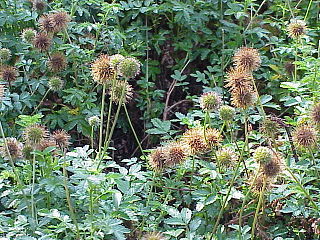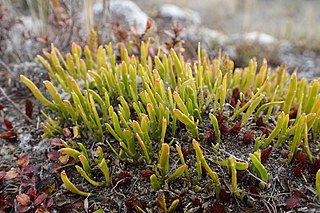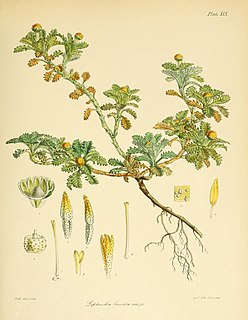
Acaena is a genus of about 60 species of mainly evergreen, creeping herbaceous perennial plants and subshrubs in the family Rosaceae, native mainly to the Southern Hemisphere, notably New Zealand, Australia and South America, but with a few species extending into the Northern Hemisphere, north to Hawaii and California.
Acaena tesca is a species of low growing perennial plant restricted to the upper slopes of the mountains of central Otago and northern Southland in the South Island of New Zealand.

Pleurophyllum speciosum, also known as the giant emperor daisy or Campbell Island daisy, is a megaherb native to the Auckland and Campbell Islands of New Zealand. A false colour image is depicted on the lower left corner on the reverse of the current five dollar New Zealand banknote. The Campbell Island daisy was first described by Joseph Dalton Hooker in Flora Antarctica of 1844, after he had collected it during the Ross expedition.

Poa foliosa is a species of tussock grass commonly known as muttonbird poa. It is native to the subantarctic islands of New Zealand and Australia.

Chionochloa antarctica is a species of grass, endemic to the Auckland and Campbell Islands.

Anthoxanthum brunonis is a species of grass, native to the South Island of New Zealand and to the Auckland and Campbell Islands.

Sophora chathamica, the coastal kōwhai, sometimes known as Chatham Island kōwhai, is one of 8 species of native sophora or kōwhai in New Zealand and grows naturally in the north-west of the North Island in New Zealand, as far south as the Tongaporutu River in north Taranaki, and as far north as Te Paki. It can also be found growing near Wellington and the Chatham Islands, although these later plantings are thought to be a result of Māori plantings in the late 18th century and early 19th century. Prior to 2001, it was included as variant of Sophora microphylla, therefore references to either Sophora microphylla var. chathamica or Sophora microphylla subsp. microphylla var. chathamica are considered references to coastal kowhai.

Scaevola gracilis is a plant in the family Goodeniaceae, native to the Kermadec Islands and Tonga.

Carmichaelia nana is a species of plant in the family Fabaceae. It is found in both the North and South Islands of New Zealand. Its conservation status in 2013 was assessed as "At Risk (declinining)" under the New Zealand Threat Classification System, but in 2018 its risk under the same system became "Threatened-Nationally Vulnerable".

Tupeia is a monotypic genus of semi-parasitic shrubs (mistletoes) which occurs in both the North and South Islands of New Zealand. There is only one species in the genus: Tupeia antarctica. There are no synonyms.

Anisotome antipoda is a species of flowering plant in the family Apiaceae, which is endemic to the Auckland, Campbell and Antipodes Islands.

Abrotanella rosulata is a plant in the family Asteraceae, endemic to the Campbell Islands.

Myosotis capitata is a species of flowering plant in the family Boraginaceae, endemic to the Campbell and Auckland Islands of New Zealand. Joseph Dalton Hooker described the species in his 19th century work Flora Antarctica. Plants of this species of forget-me-not are perennial and erect, and have ebracteate inflorescences and blue corollas. It is one of two native species of Myosotis in the New Zealand subantarctic islands, the other being M. antarctica, which can also have blue corollas.

Isolepis aucklandica is a species of flowering plant in the Cyperaceae family. It is native to New Zealand, Australia, Argentina, Peru, Colombia, Ecuador, Macquarie Island, the French Southern Territories of Saint Paul and Amsterdam Islands, and New Guinea.
Acaena antarctica is a small herbaceous plant in the Rosaceae family native to Argentina, Chile and the Falkland Islands.

Plantago aucklandica is a flowering plant in the family Plantaginaceae that is endemic to the Auckland Islands.

Gentianella cerina is a plant species in the Gentianaceae family, endemic to the Auckland Islands of New Zealand.

Leptinella lanata is a small flowering plant in the daisy family, native to the Antipodean Islands. Its specific epithet, lanata, describes its woolly-haired (lanate) rhizomes.

Dracophyllum filifolium is a species of shrub or tree endemic to the North, South, and Stewart Islands of New Zealand. It was first described by Joseph Dalton Hooker in 1853 and gets the specific epithet filifolium for its leaves being like a filament. In the heath family Ericaceae, it inhabits mountain slopes, saddles and ridges and reaches a height of 1–4 m (3–13 ft). A 2017 assessment using the New Zealand Threat Classification System classified it as “Not Threatened,” giving it an estimated population of more than 100,000.

Celmisia major is a species of daisy that is endemic to New Zealand. It is split into two different varieties, Celmisia major var. major and Celmisia major var. brevis. Despite being in the same species, it is thought that the two varieties are not close to one another, with botanist Peter James de Lange stressing critical study on the taxonomy of the daisies. It was first described by Thomas Cheeseman in 1925. The major variety is found in the Auckland area and nearby islands, while the brevis variety is confined to Mount Taranaki.




















